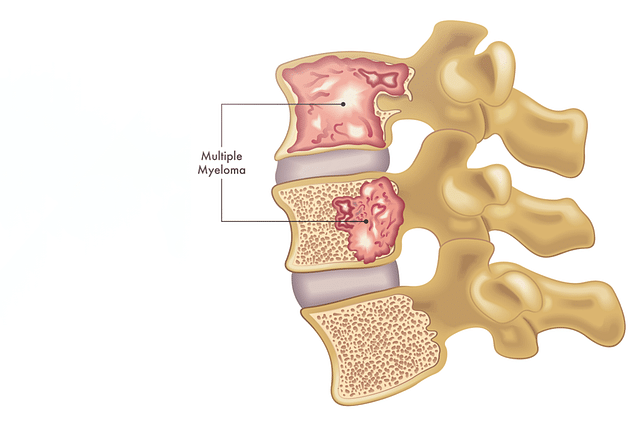Multiple Myeloma
Multiple myeloma is a type of blood cancer that affects plasma cells, a type of white blood cell responsible for producing antibodies. The disease is characterised by the abnormal multiplication of plasma cells in the bone marrow, leading to various complications such as bone damage, anaemia, and kidney problems. Treatment options for multiple myeloma depend on the stage and severity of the disease, as well as the patient's overall health.
Last updated on : 16 Dec, 2024
Read time : 15 mins

Overview of Disease
Multiple myeloma is a complex and challenging condition that arises when plasma cells, a type of white blood cell, become cancerous and multiply uncontrollably in the bone marrow. As these abnormal cells accumulate, they disrupt the production of normal blood cells and antibodies, leading to a range of health problems. In this article, we will examine the various types, causes, and complications of multiple myeloma to provide a comprehensive overview of this blood cancer.
What is Multiple Myeloma?
Multiple myeloma is a cancer that affects the plasma cells, which are responsible for producing antibodies to fight infections. In myeloma, these cells become malignant and proliferate excessively, crowding out normal blood cells in the bone marrow. This leads to compromised immune systems, anaemia, and other complications. The abnormal plasma cells also produce an excess of monoclonal proteins (M-proteins), which can cause kidney damage and other issues. The exact causes of multiple myeloma are not fully understood, but factors such as age, gender, and race may play a role in its development.
Key Factors about Multiple Myeloma
| Category | Details |
| Also Referred as | Kahler's disease, plasma cell myeloma, myelomatosis |
| Commonly Occurs In | Adults over 50, males, African Americans |
| Affected Organ | Bone marrow, bones, kidneys, immune system |
| Type | Active multiple myeloma, smouldering multiple myeloma (SMM), monoclonal gammopathy of undetermined significance (MGUS), solitary plasmacytoma |
| Common Signs | Bone pain, fatigue, weight loss, frequent infections, kidney problems, hypercalcaemia |
| Consulting Specialist | Haematologists, oncologists |
| Treatement Procedures | Chemotherapy, radiation therapy, stem cell transplant, targeted therapies |
| Managed By | Chemotherapy (Vincristine, Daunorubicin & Mercaptopurine), Radiation therapy, Targeted therapy (Bortezomib & Carfilzomib), Immunotherapy (Belantamab, Daratumumab, Elotuzumab & Isatuximab), Corticosteroids, Bone marrow tr |
| Mimiciking Condition | Other plasma cell disorders (MGUS, SMM, solitary plasmacytoma, light chain amyloidosis) |
Types of Multiple Myeloma
Multiple myeloma is categorised into different types based on the characteristics of the disease and the presence of specific genetic abnormalities. These include:
Light chain myeloma: Also known as light chain amyloidosis, this subtype is characterised by the production of light chain proteins that can accumulate in various organs, causing damage. Early detection and treatment are crucial to prevent irreversible organ dysfunction.
Non-secretory myeloma: This rare form of multiple myeloma is challenging to diagnose because the myeloma cells do not produce measurable amounts of monoclonal immunoglobulin in the blood or urine. The diagnosis of this subtype often relies on biopsy findings.
Solitary plasmacytoma: Solitary plasmacytoma presents as a single tumour composed of plasma cells, which can occur either in the bone (osseous) or outside the bone (extramedullary). Unlike multiple myeloma, it is localised and may have a better prognosis with appropriate treatment, such as radiation therapy or surgery.
Extramedullary plasmacytoma: This type of solitary plasmacytoma occurs outside the bone marrow, often in the head and neck region. It is a unique condition that requires specific treatment considerations.
Monoclonal gammopathy of undetermined significance (MGUS): MGUS is a precursor condition to multiple myeloma, characterised by the presence of monoclonal immunoglobulin in the blood without symptoms of multiple myeloma. While not a type of myeloma itself, MGUS carries a small risk of progressing to multiple myeloma.
Smouldering multiple myeloma (SMM): SMM is an asymptomatic condition with a higher level of monoclonal immunoglobulin in the blood than MGUS and possibly more plasma cells in the bone marrow. It has a higher risk of progressing to active multiple myeloma compared to MGUS.
Immunoglobulin D (IgD) myeloma: This rare subtype is characterised by the production of IgD monoclonal immunoglobulin. IgD myeloma often presents with advanced disease and may have a more aggressive course compared to other subtypes.
Immunoglobulin E (IgE) myeloma: Another rare subtype, IgE myeloma is associated with the production of IgE monoclonal immunoglobulin. Due to its rarity, the clinical features and prognosis of IgE myeloma are not well defined.
Symptoms of Multiple Myeloma
In the early stages, multiple myeloma may not cause any symptoms. As the disease progresses, some common symptoms that may develop include:
Bone pain: Caused by bone damage and lesions, patients may experience persistent pain in the back, ribs, or other bones.
Fatigue: Anaemia resulting from low red blood cell production can lead to feelings of weakness, tiredness, and shortness of breath.
Frequent infections: A weakened immune system makes patients more susceptible to infections, such as pneumonia or urinary tract infections.
Kidney problems: High levels of M-protein can damage the kidneys, leading to kidney failure or other complications.
Hypercalcaemia: Elevated calcium levels in the blood due to bone breakdown can cause symptoms like confusion, constipation, and excessive thirst.
How Does Multiple Myeloma Affect Your Body?
Multiple myeloma can have widespread effects on the body due to the abnormal growth of plasma cells, leading to various complications. These include:
Bone health: Myeloma can lead to bone damage, resulting in osteoporosis and an increased risk of fractures due to the weakening of bones.
Blood cell production: The disease interferes with the production of healthy blood cells, leading to anaemia, increased susceptibility to infections, and bleeding issues.
Kidney function: Myeloma can cause kidney damage, resulting in decreased kidney function and potentially leading to kidney failure.
Calcium levels: Increased calcium levels in the blood (hypercalcaemia) may occur, causing symptoms like nausea, constipation, confusion, and fatigue.
Immune system: The abnormal plasma cells can compromise the immune system, making patients more vulnerable to infections and illnesses.
Pain: Bone lesions and fractures can lead to chronic pain, affecting mobility and quality of life.
Stages of Multiple Myeloma
Multiple myeloma is staged using two primary systems: the International Staging System (ISS) and the Durie-Salmon staging system.
The stages of multiple myeloma, according to the International Staging System (ISS) include:
Stage 1: Characterised by a serum beta-2 microglobulin level of less than 3.5 mg/L and an albumin level of 3.5 g/dL or greater.
Stage 2: Defined by a serum beta-2 microglobulin level between 3.5 and 5.5 mg/L, regardless of the albumin level, or a beta-2 microglobulin level less than 3.5 mg/L with an albumin level less than 3.5 g/dL.
Stage 3: Indicates a serum beta-2 microglobulin level of 5.5 mg/L or greater, suggesting a more aggressive disease.
The stages of multiple myeloma, according to the Durie-Salmon Staging System, include:
Stage 1: Indicates a small number of myeloma cells with minimal bone damage, normal calcium levels, and low levels of monoclonal protein (M-protein) in the blood or urine.
Stage 2: Represents a moderate number of myeloma cells with features between stage 1 and stage 3, including moderate bone damage and higher levels of M-protein.
Stage 3: Characterised by a large number of myeloma cells with significant bone damage, high calcium levels, and high levels of M-protein in the blood or urine.
Causes of Multiple Myeloma
While the exact cause of multiple myeloma is not known, several factors have been identified that may contribute to the development of this cancer. These include:
Genetic factors: Abnormalities in the genetic material of plasma cells can lead to the development of multiple myeloma. These genetic changes can occur spontaneously or be inherited.
Environmental factors: Exposure to certain chemicals, such as benzene and radiation, may increase the risk of developing multiple myeloma.
Age: The risk of multiple myeloma increases with age, with most cases occurring in people over 60 years old.
Family history: A family history of multiple myeloma or other cancers may increase an individual's risk of developing the disease.
Risk Factors
Several factors can increase the risk of developing multiple myeloma, including:
Age (over 65 years old)
Gender (more common in men)
Race (higher risk in African Americans)
Family history
Excess body weight
Exposure to certain substances (such as radiation, asbestos, petroleum, agricultural or woodworking chemicals, benzene, dioxins, pesticides, and herbicides)
People with monoclonal gammopathy of undetermined significance (MGUS) or solitary plasmacytoma
Immune system impairment (such as HIV and human T-lymphotropic virus)
People in certain occupations, such as agricultural and farm workers, cosmetologists, petroleum workers, and leather industry employees
Complications
Multiple myeloma can lead to various complications that can significantly impact a patient's quality of life and overall health. Some of the complications include:
Infections: Due to the disease's impact on the immune system, patients with multiple myeloma are more susceptible to various infections.
Bone problems: Multiple myeloma can cause a range of bone-related issues, including bone pain, osteoporosis (thinning of bones), and an increased risk of fractures. These complications arise from the disease's interference with the normal bone remodelling process, leading to weakened and fragile bones.
Kidney problems: The accumulation of monoclonal proteins (M proteins) in the kidneys can lead to kidney problems, including kidney failure. This occurs when the excessive proteins produced by the myeloma cells overwhelm the kidneys' filtering capacity, causing damage and impaired function.
Anaemia: Multiple myeloma can cause anaemia, a condition in which the body lacks enough healthy red blood cells to carry adequate oxygen to the tissues. Anaemia can cause fatigue, weakness, pale skin, and shortness of breath.
Hypercalcaemia: The breakdown of bones releases calcium into the bloodstream, leading to high calcium levels (hypercalcaemia). This can cause symptoms such as excessive thirst, frequent urination, constipation, nausea, and mental confusion.
Prevention of Multiple Myeloma
While there is no guaranteed way to prevent multiple myeloma, certain lifestyle choices and practices may help reduce the risk. These include:
Healthy diet: Eating a balanced diet rich in fruits, vegetables, whole grains, and lean proteins can support overall health and may lower cancer risk. Antioxidant-rich foods may also play a protective role.
Regular exercise: Engaging in regular physical activity helps maintain a healthy weight, supports immune function, and may reduce the risk of certain cancers, including multiple myeloma.
Avoiding tobacco: Quitting smoking and avoiding tobacco products can significantly lower the risk of various cancers, including multiple myeloma.
Limiting alcohol consumption: Reducing alcohol intake may also help decrease cancer risk. It’s recommended to consume alcohol in moderation or not at all.
Managing obesity: Maintaining a healthy weight is important, as obesity has been linked to an increased risk of multiple myeloma and other cancers.
Regular check-ups: Routine medical check-ups can help identify any health issues early on. Discussing personal and family medical history with a doctor can also provide insights into potential risks.
Diagnosis & Tests
Diagnosing multiple myeloma involves a combination of physical examinations, laboratory tests, and imaging studies. These include:
Physical examination: During a physical exam, the doctor will check for signs of multiple myeloma, such as bone pain, weakness, fatigue, and signs of infection. They may also examine the abdomen for signs of an enlarged liver or spleen.
Complete blood count (CBC): This test measures the levels of red blood cells, white blood cells, and platelets in the blood. Multiple myeloma can cause anaemia and other blood-related abnormalities.
Blood chemistry tests: These tests measure the levels of various substances in the blood, such as calcium, creatinine, and albumin, which can be affected by multiple myeloma.
Quantitative immunoglobulins: This test measures the levels of different types of antibodies (immunoglobulins) in the blood. Multiple myeloma often causes an increase in one type of immunoglobulin.
Serum protein electrophoresis (SPEP): This test separates proteins in the blood or urine based on their size and electrical charge, helping to identify the presence of monoclonal proteins (M proteins) produced by myeloma cells.
Free light chain assay: This test measures the levels of free light chains, which are components of antibodies that can be elevated in multiple myeloma.
Bone marrow biopsy: A bone marrow biopsy involves removing a small sample of bone marrow, usually from the hip bone, using a needle. The sample is then examined under a microscope to look for myeloma cells and assess the extent of the disease.
X-rays: X-rays can show bone damage caused by multiple myeloma, such as thinning of the bones (osteoporosis) or lytic lesions (holes in the bones).
Computed tomography (CT) scan: This detailed imaging test can help identify bone lesions and assess the extent of bone damage.
Magnetic resonance imaging (MRI): An MRI can provide detailed images of the bone marrow and soft tissues to detect myeloma-related abnormalities.
Positron emission tomography (PET) scan: A PET scan uses a small amount of radioactive glucose to identify areas of active myeloma cells in the body.
Treatment & Management
Treating multiple myeloma requires a comprehensive approach that combines various therapies to manage the disease effectively. These include:
Chemotherapy: Chemotherapy is a standard treatment for multiple myeloma, often using medications such as vincristine, daunorubicin, and mercaptopurine to kill cancer cells.
Targeted therapy: Targeted therapies focus on specific characteristics of myeloma cells. Agents like bortezomib and carfilzomib target the growth and survival pathways of these cells, helping to control the disease while minimising side effects.
Immunotherapy: Immunotherapy harnesses the body’s immune system to combat cancer. Medicines such as belantamab, daratumumab, elotuzumab, and isatuximab can effectively target myeloma cells.
Radiation therapy: Radiation therapy may be employed to target specific areas affected by myeloma, particularly painful bone lesions or other localised complications, providing relief and improving quality of life.
Bone marrow transplant: For eligible patients, a bone marrow transplant may be considered. This involves high-dose chemotherapy followed by the infusion of healthy stem cells to restore bone marrow function, potentially leading to longer remission periods.
Supportive care: Managing symptoms and complications is vital in multiple myeloma treatment. This includes pain management, treating anaemia, and addressing issues like kidney dysfunction and bone health, often using bisphosphonates or denosumab to strengthen bones.
Living with Disease
Living with multiple myeloma can be challenging, but there are several ways to manage the condition and maintain a good quality of life. These include:
Adhere to the prescribed treatment plan and attend regular follow-up appointments.
Manage symptoms and side effects of treatment, such as fatigue, pain, and neuropathy.
Maintain a healthy lifestyle, including a balanced diet, regular exercise, and adequate rest.
Stay informed about the disease and treatment options.
Seek support from family, friends, or support groups.
When to See a Doctor?
If you experience any symptoms suggestive of multiple myeloma, such as persistent bone pain, unexplained fractures, frequent infections, anaemia, or kidney problems, it's important to see a doctor promptly. For people living with myeloma, it's crucial to attend regular follow-up appointments and report any new symptoms or treatment side effects to the doctor. Seeking prompt medical attention for any concerning signs can help detect and manage complications early.
Key Takeaways
Multiple myeloma is a type of blood cancer that affects plasma cells in the bone marrow.
Common symptoms include bone pain, fractures, frequent infections, fatigue, and kidney problems.
The exact causes of multiple myeloma are unknown, but factors such as age, race, and family history may increase the risk.
Diagnosis involves blood and urine tests, imaging studies, and bone marrow biopsy.
Treatment options include induction therapy, stem cell transplant, supportive treatments, and advanced therapies like immunotherapy.
Living with multiple myeloma involves following a treatment plan, maintaining a healthy lifestyle, and seeking support when needed.
Regular check-ups and prompt reporting of new or worsening symptoms are essential for effective management of the condition.
FAQs
What is life expectancy of someone with multiple myeloma?
The life expectancy for multiple myeloma patients varies, depending on factors like age, disease stage, and treatment response. Overall, the five-year survival rate is around 60%.
Is multiple myeloma a serious cancer?
Multiple myeloma is a serious and progressive cancer that can damage the bones, immune system, kidneys, and red blood cells, leading to complications.
Can you fully recover from multiple myeloma?
Currently, multiple myeloma is considered incurable. Treatment can manage the disease and improve quality of life, but the cancer typically returns after remission.
Is multiple myeloma one of the worst cancers?
The severity of multiple myeloma is subjective and depends on individual factors. However, it can cause significant morbidity and mortality if not managed effectively.
What is stage 1 multiple myeloma?
Stage 1 multiple myeloma features lower beta-2-microglobulin and higher albumin levels compared to other stages, and there are no significant genetic abnormalities.
How serious is myeloma cancer?
Myeloma cancer is a serious condition that can cause significant damage to various body systems and lead to complications if not properly managed.
Can multiple myeloma be cured?
Despite advancements in treatments like chemotherapy, stem cell transplants, and immunotherapies, multiple myeloma is currently considered incurable, as the disease often recurs after a period of remission.
What is the cause of multiple myeloma?
The exact cause of multiple myeloma is unknown, but factors like age, race, family history, and exposure to certain chemicals or radiation may increase the risk.
Which virus can cause multiple myeloma?
Some studies suggest that certain viruses, such as the Epstein-Barr virus (EBV) and human herpesvirus 8 (HHV-8), may be associated with an increased risk of developing multiple myeloma.
References
American Cancer Society. (2021, March 2). What is multiple myeloma? https://www.cancer.org/cancer/multiple-myeloma/about/what-is-multiple-myeloma.html
National Cancer Institute. (2021, March 11). Treatment options for multiple myeloma. https://www.cancer.gov/types/myeloma/patient/myeloma-treatment-pdq
MedlinePlus. (2022). Multiple myeloma. https://medlineplus.gov/ency/article/000583.htm
Khouri, J., Saleh, A., & Dasanu, C. A. (2022). Multiple myeloma. In StatPearls. StatPearls Publishing. https://www.ncbi.nlm.nih.gov/books/NBK534764/
NHS. (n.d.). Multiple myeloma. https://www.nhs.uk/conditions/multiple-myeloma/
Check Related Salts
Latest health articles
Top Health Essentials
Disclaimer
Top-Selling Medicines:
...View more
Top-OTC medicines:
...View more
Subscribe
Registered Office Address
Grievance Officer
Download Truemeds

Contact Us
Our customer representative team is available 7 days a week from 9 am - 9 pm.
v3.7.5
Our Payment Partners























































